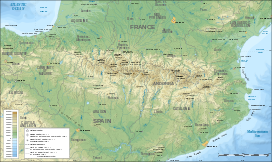Pic du Midi de Bigorre
| Pic du Midi de Bigorre | |
|---|---|
 |
|
| Highest point | |
| Elevation | 2,877 m (9,439 ft) |
| Coordinates | 42°56′11″N 0°08′34″E / 42.93639°N 0.14278°ECoordinates: 42°56′11″N 0°08′34″E / 42.93639°N 0.14278°E |
| Geography | |
|
|
|
| Parent range | Pyrenees |
The Pic du Midi de Bigorre or simply the Pic du Midi (altitude 2,877 m (9,439 ft)) is a mountain in the French Pyrenees famous for its Pic du Midi Observatory.
The Pic du Midi Observatory (French: Observatoire du Pic du Midi) is an astronomical observatory located at 2877 meters on top of the Pic du Midi de Bigorre mountain in the French Pyrenees. It is part of the Midi-Pyrenees Observatory (French: Observatoire Midi-Pyrénées; OMP) which has additional research stations in the southwestern French towns of Tarbes, Lannemezan, and Auch, as well as many partnerships in South America, Africa, and Asia, due to the guardianship it receives from the French Research Institute for Development (IRD).
Construction of the observatory began in 1878 under the auspices of the Société Ramond, but by 1882 the society decided that the spiralling costs were beyond its relatively modest means, and yielded the observatory to the French state, which took it into its possession by a law of 7 August 1882. The 8 metre dome was completed in 1908, under the ambitious direction of Benjamin Baillaud. It housed a powerful mechanical equatorial reflector which was used in 1909 to formally discredit the Martian canal theory. In 1946 Mr. Gentilli funded a dome and a 0.60-meter telescope, and in 1958, a spectrograph was installed.
A 1.06-meter (42-inch) telescope was installed in 1963, funded by NASA and was used to take detailed photographs of the surface of the Moon in preparation for the Apollo missions. In 1965 the astronomers Pierre and Janine Connes were able to formulate a detailed analysis of the composition of the atmospheres on Mars and Venus, based on the infrared spectra gathered from these planets. The results showed atmospheres in chemical equilibrium. This served as a basis for James Lovelock, a scientist working for the Jet Propulsion Laboratory in California, to predict that those planets had no life - a fact that would be proven and scientifically accepted years after.
...
Wikipedia

